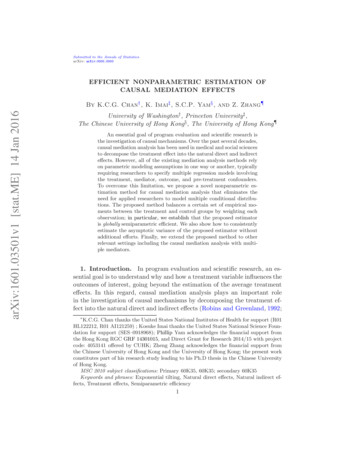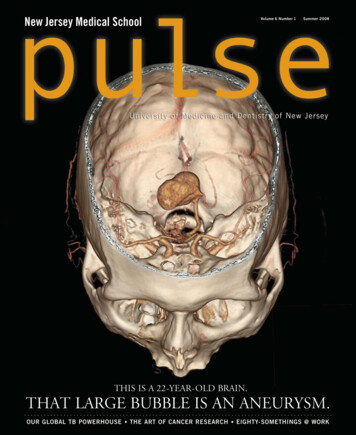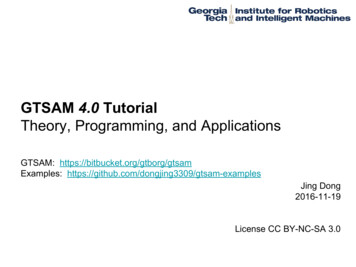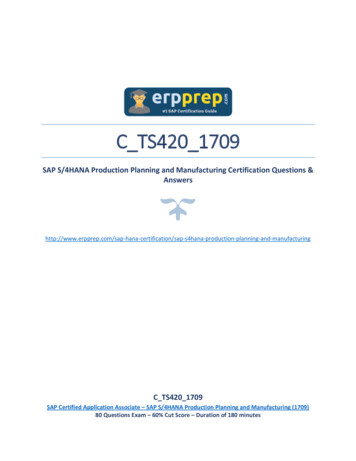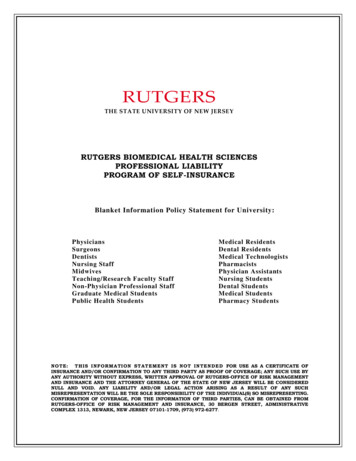![ArXiv:1709.05254v2 [cs.LG] 1 Aug 2018 - University Of St. Gallen](/img/34/gtc-2018-final.jpg)
Transcription
Detection of Anomalies in Large-ScaleAccounting Data using Deep AutoencoderNetworksarXiv:1709.05254v2 [cs.LG] 1 Aug 2018Marco Schreyer1 , Timur Sattarov2 , Damian Borth1 ,Andreas Dengel1 , and Bernd Reimer21German Research Center for Artificial Intelligence (DFKI) GmbHTrippstadter Straße 112, Kaiserslautern, oopers (PwC) GmbH,Friedrichstraße 14, Stuttgart, Germanylastname.firstname@pwc.comAbstract. Learning to detect fraud in large-scale accounting data is oneof the long-standing challenges in financial statement audits or fraud investigations. Nowadays, the majority of applied techniques refer to handcrafted rules derived from known fraud scenarios. While fairly successful,these rules exhibit the drawback that they often fail to generalize beyondknown fraud scenarios and fraudsters gradually find ways to circumventthem. To overcome this disadvantage and inspired by the recent successof deep learning we propose the application of deep autoencoder neuralnetworks to detect anomalous journal entries. We demonstrate that thetrained network’s reconstruction error obtainable for a journal entry andregularized by the entry’s individual attribute probabilities can be interpreted as a highly adaptive anomaly assessment. Experiments on tworeal-world datasets of journal entries, show the effectiveness of the approach resulting in high f1 -scores of 32.93 (dataset A) and 16.95 (datasetB) and less false positive alerts compared to state of the art baselinemethods. Initial feedback received by chartered accountants and fraudexaminers underpinned the quality of the approach in capturing highlyrelevant accounting anomalies.Keywords: Accounting Information Systems · Computer Assisted Audit Techniques (CAATs) · Journal Entry Testing · Forensic Accounting· Fraud Detection · Forensic Data Analytics · Deep Learning1MotivationThe Association of Certified Fraud Examiners estimates in its Global FraudStudy 2016 [1] that the typical organization lost 5% of its annual revenues dueto fraud. The term ”fraud” refers to ”the abuse of one’s occupation for personalenrichment through the deliberate misuse of an organization’s resources or assets” [47]. A similar study, conducted by PwC, revealed that nearly a quarter
2Schreyer, Sattarov et al.DataAccountingProcessAccounting Information System (AIS)Incoming Invoice( 1000)DebitExpensesCredit 1000CompanyAAAAAABBB.Entry ID100011100012900124.Outgoing Payment( 1000)DebitLiabilities 1000Fiscal 0.201601.02.2017.e.g. table: “Accounting Document Header“CreditDebitBank 1000Credit 1000e.g. table: “Accounting Document Segment“CompanyAAAAAABBB.Entry D.Fig. 1. Hierarchical view of an Accounting Information System (AIS) that recordsdistinct layer of abstractions, namely (1) the business process, (2) the accounting and(3) technical journal entry information in designated database tables.(22%) of respondents experienced losses between 100’000 and 1 million due tofraud [39]. The study also showed that financial statement fraud caused by farthe highest median loss of the surveyed fraud schemes3 .At the same time, organizations accelerate the digitization and reconfiguration of business processes [32] affecting in particular Accounting InformationSystems (AIS) or more generally Enterprise Resource Planning (ERP) systems.Steadily, these systems collect vast quantities of electronic evidence at an almost”atomic” level. This holds in particular for the journal entries of an organization recorded in its general ledger and sub-ledger accounts. SAP, one of themost prominent enterprise software providers, estimates that approx. 76% of theworld’s transaction revenue touches one of their ERP systems [41]. Figure 1 depicts a hierarchical view of an AIS recording process of journal entry informationin designated database tables.To detect potentially fraudulent activities international audit standards require the direct assessment of journal entries [2],[22]. Nowadays, the majority ofapplied techniques to examine journal entries refer to rules defined by experienced chartered accountants or fraud examiners that are handcrafted and oftenexecuted manually. The techniques, usually based on known fraud scenarios, areoften referred to as ”red-flag” tests (e.g. postings late at night, multiple vendorbank account changes, backdated expense account adjustments) or statisticalanalyses (e.g. Benford’s Law [9], time series evaluation). Unfortunately, they often don’t generalize beyond historical fraud cases already known and therefore3The ACFE study encompasses an analysis of 2’410 cases of occupational fraud investigated between January 2014 and October 2015 that occurred in 114 countries.The PwC study encompasses over 6’000 correspondents that experienced economiccrime in the last 24 months.
Detection of Accounting Anomalies Using Deep AE Networks3fail to detect novel schemes of fraud. In addition, such rules become rapidlyoutdated while fraudsters adaptively find ways to circumvent them.Recent advances in deep learning [31] enabled scientists to extract complexnonlinear features from raw sensory data leading to breakthroughs across manydomains e.g. computer vision [29] and speech recognition [34]. Inspired by thosedevelopments we propose the application of deep autoencoder neural networksto detect anomalous journal entries in large volumes of accounting data. Weenvision this automated and deep learning based examination of journal entriesas an important supplement to the accountants and forensic examiners toolbox[38].In order to conduct fraud, perpetrators need to deviate from regular systemusage or posting pattern. Such deviations are recorded by a very limited numberof ”anomalous” journal entries and their respective attribute values. Based onthis observation we propose a novel scoring methodology to detect anomalousjournal entries in large scale accounting data. The scoring considers (1) themagnitude of a journal entry’s reconstruction error obtained by a trained deepautoencoder network and (2) regularizes it by the entry’s individual attributeprobabilities. This anomaly assessment is highly adaptive to the often varyingattribute value probability distributions of journal entries. Furthermore, it allowsto flag entries as ”anomalous” if they exceed a predefined scoring threshold. Weevaluate the proposed method based on two anonymized real-world datasets ofjournal entries extracted from large-scale SAP ERP systems. The effectiveness ofthe proposed method is underpinned by a comparative evaluation against stateof the art anomaly detection algorithms.In section 2 we provide an overview of the related work. Section 3 follows witha description of the autoencoder network architecture and presents the proposedmethodology to detect accounting anomalies. The experimental setup and resultsare outlined in section 4 and section 5. In section 6 the paper concludes with asummary of the current work and future directions of research.2Related workThe task of detecting fraud and accounting anomalies has been studied both bypractitioners [47] and academia [3]. Several references describe different fraudschemes and ways to detect unusual and ”creative” accounting practices [44]. Theliterature survey presented hereafter focuses on (1) the detection of fraudulentactivities in Enterprise Resource Planning (ERP) data and (2) the detection ofanomalies using autoencoder networks.2.1Fraud Detection in Enterprise Resource Planning (ERP) DataThe forensic analysis of journal entries emerged with the advent of EnterpriseResource Planning (ERP) systems and the increased volume of data recorded bysuch systems. Bay et al. in [8] used Naive Bayes methods to identify suspiciousgeneral ledger accounts, by evaluating attributes derived from journal entries
4Schreyer, Sattarov et al.measuring any unusual general ledger account activity. Their approach was enhanced by McGlohon et al. applying link analysis to identify (sub-) groups ofhigh-risk general ledger accounts [33].Kahn et al. in [27] and [26] created transaction profiles of SAP ERP users.The profiles are derived from journal entry based user activity pattern recordedin two SAP R/3 ERP system in order to detect suspicious user behavior andsegregation of duties violations. Similarly, Islam et al. used SAP R/3 systemaudit logs to detect known fraud scenarios and collusion fraud via a ”red-flag”based matching of fraud scenarios [23].Debreceny and Gray in [17] analyzed dollar amounts of journal entries obtained from 29 US organizations. In their work, they searched for violationsof Benford’s Law [9], anomalous digit combinations as well as unusual temporal pattern such as end-of-year postings. More recently, Poh-Sun et al. in [43]demonstrated the generalization of the approach by applying it to journal entriesobtained from 12 non-US organizations.Jans et al. in [24] used latent class clustering to conduct an uni- and multivariate clustering of SAP ERP purchase order transactions. Transactions significantly deviating from the cluster centroids are flagged as anomalous and areproposed for a detailed review by auditors. The approach was enhanced in [25]by a means of process mining to detect deviating process flows in an organizationprocure to pay process.Argyrou et al. in [6] evaluated self-organizing maps to identify ”suspicious”journal entries of a shipping company. In their work, they calculated the Euclidean distance of a journal entry and the code-vector of a self-organizing mapsbest matching unit. In subsequent work, they estimated optimal sampling thresholds of journal entry attributes derived from extreme value theory [7].Concluding from the reviewed literature, the majority of references draweither (1) on historical accounting and forensic knowledge about various ”redflags” and fraud schemes or (2) on traditional non-deep learning techniques. Asa result and in agreement with [46], we see a demand for unsupervised and novelapproaches capable to detect so far unknown scenarios of fraudulent journalentries.2.2Anomaly Detection using Autoencoder Neural NetworksNowadays, autoencoder networks have been widely used in image classification[21], machine translation [30] and speech processing [45] for their unsuperviseddata compression capabilities. To the best of our knowledge Hawkins et al. andWilliams et al. were the first who proposed autoencoder networks for anomalydetection [20], [48].Since then the ability of autoencoder networks to detect anomalous recordswas demonstrated in different domains such as X-ray images of freight containers[5], the KDD99, MNIST, CIFAR-10 as well as several other datasets obtainedfrom the UCI Machine Learning Repository4 [15], [4], [50]. In [51] Zhou and4https://archive.ics.uci.edu/ml/datasets.html
Detection of Accounting Anomalies Using Deep AE Networks01.11.2017Posting Time: 09:1231General-Ledger: 00404002Amount: 8.350,12Vendor: John Doe Ltd.Transaction-Code:. TC 043x1x1xi2. . . . .xi2xi3. . . . .xi3. . . . .iix4xi5. . .x4.xikxi5.xik“Latent Space” Neurons Z (z1 , z2 , , zn)Feature k.ReconstructedJournal Entry xiiFeature 2 Feature 1RE Feature 2 Posting Date:Decoder Net gΘiFeature 1Document Type:Posting Key:Encoder Net fΘInputJournal Entry xiFeature kJournal EntryAttributes j5 RE 01.11.2017 09:12 21 00404002 8.350,12 John Doe Inc. . TC 043 Correct reconstruction Incorrect reconstructionFig. 2. Schematic view of an autoencoder network comprised of two non-linear mappings (fully connected feed forward neural networks) referred to as encoder fθ : Rdx 7 Rdz and decoder gθ : Rdz 7 Rdy .Paffenroth enhanced the standard autoencoder architecture by an additionalfilter layer and regularization penalty to detect anomalies.More recently, autoencoder networks have been also applied in the domain offorensic data analysis. Cozzolino and Verdoliva used the autoencoder reconstruction error to detect pixel manipulations of images [13]. In [16] the method wasenhanced by recurrent neural networks to detect forged video sequences. Lately,Paula et al. in [35] used autoencoder networks in export controls to detect tracesof money laundry and fraud by analyzing volumes of exported goods.To the best of our knowledge, this work presents the first deep learninginspired approach to detect anomalous journal entries in real-world and largescale accounting data.3Detection of Accounting AnomaliesIn this section we introduce the main elements of autoencoder neural networks.We furthermore describe how the reconstruction error of such networks can beused to detect anomalous journal entries in large-scale accounting data.3.1Deep Autoencoder Neural NetworksWe consider the task of training an autoencoder neural network using a set ofN journal entries X {x1 , x2 , ., xn } where each journal entry xi consists ofa tuple of K attributes xi (xi1 , xi2 , ., xij , ., xik ). Thereby, xij denotes the j thattribute of the ith journal entry. The individual attributes xj encompass a journal entry’s accounting specific details e.g. posting type, posting date, amount,general-ledger. Furthermore, nij counts the occurrence of a particular attributevalue of attribute xj e.g. a specific document type or account.An autoencoder or replicator neural network defines a special type of feedforward multilayer neural network that can be trained to reconstruct its input.The difference between the original input and its reconstruction is referred toas reconstruction error. Figure 2 illustrates a schematic view of an autoencoder
6Schreyer, Sattarov et al.neural network. In general, autoencoder networks are comprised of two nonlinearmappings referred to as encoder fθ and decoder gθ network [40]. Most commonlythe encoder and the decoder are of symmetrical architecture consisting of severallayers of neurons each followed by a nonlinear function and shared parametersθ. The encoder mapping fθ (·) maps an input vector xi to a compressed representation z i in the latent space Z. This latent representation z i is then mappedback by the decoder gθ (·) to a reconstructed vector x̂i of the original inputspace. Formally, the non-linear encoder and decoder mapping of an autoencoderencompassing several layers of neurons can be defined by:fθl (·) σ l (W l (fθl 1 (·)) bl ), and gθl (·) σ 0l (W 0l (gθl 1 (·)) dl ),(1)where σ and σ 0 denote non-linear activations e.g. the sigmoid function, θ denote the model parameters {W, b, W 0 , d}, W Rdx dz , W 0 Rdz dy are weightmatrices, b Rdz , d Rdy are offset bias vectors and l denotes the number ofhidden layers.In an attempt to achieve xi x̂i the autoencoder is trained to learn a set ofoptimal encoder-decoder model parameters θ that minimize the dissimilarity ofa given journal entry xi and its reconstruction x̂i gθ (fθ (xi )) as faithfully aspossible. Thereby, the autoencoder training objective is to learn a model thatoptimizes:arg min kX gθ (fθ (X))k,(2)θfor all journal entries X. As part of the network training one typically minimizesa loss function Lθ defined by the squared reconstruction loss or, as used in ourexperiments, the cross-entropy loss given by:nLθ (xi ; x̂i ) k1 XX ix ln(x̂ij ) (1 xij )ln(1 x̂ij ),n i 1 j 1 j(3)for a set of n-journal entries xi , i 1, ., n and their respective reconstructions x̂iover all journal entry attributes j 1, ., k. For binary encoded attribute values,as used in this work, the Lθ (xi ; x̂i ) measures the deviation between two independent multivariate Bernoulli distributions, with mean x and mean x̂ respectively[10].To prevent the autoencoder from learning the identity function the numberof neurons of the networks hidden layers are reduced indicating Rdx Rdz(usually referred to as ”bottleneck” architecture). Imposing such a constraintonto the network’s hidden layer forces the autoencoder to learn an optimal setof parameters θ that result in a ”compressed” model of the most prevalentjournal entry attribute value distributions and their dependencies.3.2Classification of Accounting AnomaliesTo detect anomalous journal entries we first have to define ”normality” with respect to accounting data. We assume that the majority of journal entries recorded
Detection of Accounting Anomalies Using Deep AE Networks7within an organizations’ ERP system relate to regular day-to-day business activities. In order to conduct fraud, perpetrators need to deviate from the ”normal”.Such deviating behavior will be recorded by a very limited number of journal entries and their respective attribute values. We refer to journal entries exhibitingsuch deviating attribute values as accounting anomalies.When conducting a detailed examination of real-world journal entries, recordedin large-scaled ERP systems, two prevalent characteristics can be observed: First,journal entry attributes exhibit a high variety of distinct attribute values andsecond, journal entries exhibit strong dependencies between certain attributevalues e.g. a document type that is usually posted in combination with a certaingeneral ledger account. Derived from this observation and similarly to Breuniget al. in [11] we distinguish two classes of anomalous journal entries, namelyglobal and local anomalies:Global accounting anomalies, are journal entries that exhibit unusualor rare individual attribute values. Such anomalies usually relate to skewed attributes e.g. rarely used ledgers, or unusual posting times. Traditionally, ”redflag” tests performed by auditors during an annual audit, are designed to capturethis type of anomaly. However, such tests often result in a high volume of falsepositive alerts due to events such as reverse postings, provisions and year-endadjustments usually associated with a low fraud risk. Furthermore, when consulting with auditors and forensic accountants, ”global” anomalies often refer to”error” rather than ”fraud”.Local accounting anomalies, are journal entries that exhibit an unusualor rare combination of attribute values while their individual attribute valuesoccur quite frequently e.g. unusual accounting records, irregular combinations ofgeneral ledger accounts, user accounts used by several accounting departments.This type of anomaly is significantly more difficult to detect since perpetratorsintend to disguise their activities by imitating a regular activity pattern. Asa result, such anomalies usually pose a high fraud risk since they correspondto processes and activities that might not be conducted in compliance withorganizational standards.In regular audits, accountants and forensic examiners desire to detect journalentries corresponding to both anomaly classes that are ”suspicious” enough fora detailed examination. In this work, we interpret this concept as the detectionof (1) any unusual individual attribute value or (2) any unusual combinationof attribute values observed. This interpretation is also inspired by earlier workof Das and Schneider [14] on the detection of anomalous records in categoricaldatasets.3.3Scoring of Accounting AnomaliesBased on this interpretation we propose a novel anomaly score to detect globaland local anomalies in real-world accounting datasets. Our score accounts forboth of the observed characteristics, namely (1) any ”unusual” attribute valueoccurrence (global anomaly) and (2) any ”unusual” attribute value co-occurrence(local anomaly):
8Schreyer, Sattarov et al.Attribute value occurrence: To account for the observation of unusual orrare attribute values we determine for each value xj its probability of occurrenceniin the population of journal entries. This can be formally defined by Nj wereN counts the total number of journal entries. For example, the probability ofobserving a specific general ledger or posting key in X. In addition, we obtainPknithe sum of individual attribute value log-probabilities P (xi ) j 1 ln(1 Nj )for each journal entry xi over all its j attributes. Finally, we obtain a min-maxnormalized attribute value probability score AP denoted by:AP (xi ) P (xi ) Pmin,Pmax Pmin(4)for a given journal entry xi and its individual attributes xij , where Pmax andPmin denotes min- and max-values of the summed individual attribute valuelog-probabilities given by P .Attribute value co-occurrence: To account for the observation of irregular attribute value co-occurrences and to target local anomalies, we determinea journal entry’s reconstruction error derived by training a deep autoencoderneural network. For example, the probability of observing a certain generalledger account in combination with a specific posting type within the population of all journal entries X. Anomalous co-occurrences are hardly learnedby the network and can therefore not be effectively reconstructed from theirlow-dimensional latent representation. Therefore, such journal entries will result in a high reconstruction error. Formally, we derive the trained autoencodernetwork’s reconstruction error E as the squared- or L2-difference Eθ (xi ; x̂i ) Pk1ii 2iij 1 (xj x̂j ) for a journal entry x and its reconstruction x̂ under optimalk model parameters θ . Finally, we calculate the normalized reconstruction errorRE denoted by:REθ (xi ; x̂i ) Eθ (xi ; x̂i ) Eθ ,min,Eθ ,max Eθ ,min(5)where Emin and Emax denotes the min- and max-values of the obtained reconstruction errors given by Eθ .Accounting anomaly scoring: Observing both characteristics for a singlejournal entry, we can reasonably conclude (1) if an entry is anomalous and(2) if it was created by a ”regular” business activity. It also implies that wehave seen enough evidence to support our judgment. To detect global and localaccounting anomalies in real-world audit scenarios we propose to score eachjournal entry xi by its reconstruction error RE regularized by its normalizedattribute probabilities AP given by:AS(xi ; x̂i ) α REθ (xi ; x̂i ) (1 α) AP (xi ),(6)for each individual journal entry xi and optimal model parameters θ . We introduce α as a factor to balance both characteristics. In addition, we flag a journal
Detection of Accounting Anomalies Using Deep AE NetworksAEAEAEAEAEAEAEAEAEAE9Fully Connected Layers and ;[401;[401;576]-3-[401; 576]576]-4-3-4-[401; 576]576]-8-4-3-4-8-[401; 576]576]-16-8-4-3-4-8-16-[401; 576]576]-32-16-8-4-3-4-8-16-32-[401; 576]576]-64-32-16-8-4-3-4-8-16-32-64-[401; 576]576]-128-64-32-16-8-4-3-4-8-16-32-64-128-[401; 56-[401; 28-256-512-[401; 576]Table 1. Evaluated architecture ranging from shallow architectures (AE 1) encompassing a single fully connected hidden layer to deep architectures (AE 9) encompassingseveral hidden layers.entry as anomalous if its anomaly score AS exceeds a threshold parameter β, asdefined by:(AS(xi ; x̂i ), AS(xi ; x̂i ) βiiAS(x ; x̂ ) ,(7)0,otherwisefor each individual journal entry xi under optimal model parameters θ .4Experimental Setup and Network TrainingIn this section we describe the experimental setup and model training. We evaluated the anomaly detection performance of nine distinct autoencoder architectures based on two real-world datasets of journal entries.4.1Datasets and Data PreparationBoth datasets have been extracted from SAP ERP instances, denoted SAP ERPdataset A and dataset B in the following, encompassing the entire population ofjournal entries of a single fiscal year. In compliance with strict data privacy regulations, all journal entry attributes have been anonymized using an irreversibleone-way hash function during the data extraction process. To ensure data completeness, the journal entry based general ledger balances were reconciled againstthe standard SAP trial balance reports e.g. the SAP ”RFBILA00” report.In general, SAP ERP systems record a variety of journal entry attributespredominantly in two tables technically denoted by ”BKPF” and ”BSEG”. Thetable ”BKPF” - ”Accounting Document Header” contains the meta information of a journal entry e.g., document id, type, date, time, currency. The table”BSEG” - ”Accounting Document Segment”, also referred to journal entry lineitems, contains the entry details e.g., posting key, general ledger account, debitand credit information, amount. We extracted a subset of 6 (dataset A) and 10(dataset B) most discriminative attributes of the ”BKPF” and ”BSEG” tables.The majority of attributes recorded in ERP systems correspond to categorical(discrete) variables, e.g. posting date, account, posting type, currency. In order
Schreyer, Sattarov et al.autoencoder training performance, recall 1.0AE 1AE 2AE 3AE 4AE 50.12% detected anomalies0.10AE 6AE 7AE 8AE 90.080.060.040.020.000250500750 1000 1250# training epochs150017502000feature training performance0.5% not reconstructed samples10bkpf feature 1bkpf feature 2bkpf feature 3bseg feature 4bseg feature 5bseg feature 6bseg feature 7bseg feature 8bseg feature 9bseg feature 100.40.30.20.10.0050100150200250# training epochs300350400Fig. 3. Training performance using dataset A of the evaluated autoencoder architectures AE 1 - AE 9 (left). Training performance using dataset B of the individual journalentry attributes (right).to train autoencoder neural networks, we preprocessed the categorical journalentry attributes to obtain a binary (”one-hot” encoded) representation of eachjournal entry. This preprocessing resulted in a total of 401 encoded dimensionsfor dataset A and 576 encoded dimensions for dataset B.To allow for a detailed analysis and quantitative evaluation of the experiments we injected a small fraction of synthetic global and local anomalies intoboth datasets. Similar to real audit scenarios this resulted in highly unbalancedclass distribution of ”anomalous” vs. ”regular” day-to-day entries. The injectedglobal anomalies are comprised of attribute values not evident in the originaldata while the local anomalies exhibit combinations of attribute value subsetsnot occurring in the original data. The true labels (”ground truth”) are available for both datasets. Each journal entry is labeled as either synthetic globalanomaly, synthetic local anomaly or non-synthetic regular entry. The followingdescriptive statistics summarize both datasets:– Dataset A contains a total of 307’457 journal entry line items comprised of 6categorical attributes. In total 95 (0.03%) synthetic anomalous journalentries have been injected into dataset. These entries encompass 55(0.016%) global anomalies and 40 (0.015%) local anomalies.– Dataset B contains a total of 172’990 journal entry line items comprised of10 categorical attributes. In total 100 (0.06%) synthetic anomalous journalentries have been injected into the dataset. These entries encompass 50(0.03%) global anomalies and 50 (0.03%) local anomalies.4.2Autoencoder Neural Network TrainingIn annual audits auditors aim to limit the number of journal entries subject tosubstantive testing to not miss any error or fraud related entry. Derived fromthis desire we formulated three objectives guiding our training procedure: (1)minimize the overall autoencoder reconstruction error, (2) focus on models that
Detection of Accounting Anomalies Using Deep AE Networks10 training epochs100 training epochs11400 training epochsFig. 4. Journal entry reconstruction error RE obtained for each of the 307.457 journalentries xi contained in dataset A after 10 (left), 100 (middle) and 400 (right) trainingepochs. The deep autoencoder (AE 8) learns to distinguish global anomalies (orange)and local anomalies (red) from original journal entries (blue) with progressing trainingepochs.exhibit a recall of 100% of the synthetic journal entries, and (3) maximize theautoencoder detection precision to reduce the number of false-positive alerts.We trained nine distinct architectures ranging from shallow (AE 1) to deep(AE 9) autoencoder networks. Table 1 shows an overview of the evaluated architectures 5 The depth of the evaluated architectures was increased by continuouslyadding fully-connected hidden layers of size 2k neurons, where k 2, 3, ., 9. Toprevent saturation of the non-linearities we choose leaky rectified linear units(LReLU) [49] and set their scaling factor to a 0.4.Each autoencoder architecture was trained by applying an equal learningrate of η 10 4 to all layers and using a mini-batch size of 128 journal entries. Furthermore, we used adaptive moment estimation [28] and initialized theweights of each network layer as proposed in [19]. The training was conductedvia standard back-propagation until convergence (max. 2’000 training epochs).For each architecture, we run the experiments five times using distinct parameterinitialization seeds to guarantee a deterministic range of result.Figure 3 (left) illustrates the performance of the distinct network topologiesevaluated for dataset A over progressing training epochs. Increasing the numberof hidden units results in faster error convergence and decreases the number ofdetected anomalies. Figure 3 (right) shows the individual attribute training performance of dataset B with progressing training. We noticed that the trainingperformance of individual attributes correlates with the number of distinct attributes values e.g. the attribute bseg attrubute 10 exhibits a total of 19 distinctvalues whereas bseg attribute 2 exhibits only 2 values and is therefore learnedfaster.5The notation: [401; 576] 3 [401; 576], denotes a network architecture consistingof three fully connected layers. An input-layer consisting of 401 or 576 neurons(depending on the encoded dimensionality of the dataset respectively), a hiddenlayer consisting of 3 neurons, as well as, an output layer consisting of 401 or 57
by a means of process mining to detect deviating process ows in an organization procure to pay process. Argyrou et al. in [6] evaluated self-organizing maps to identify "suspicious" journal entries of a shipping company. In their work, they calculated the Eu-clidean distance of a journal entry and the code-vector of a self-organizing maps
